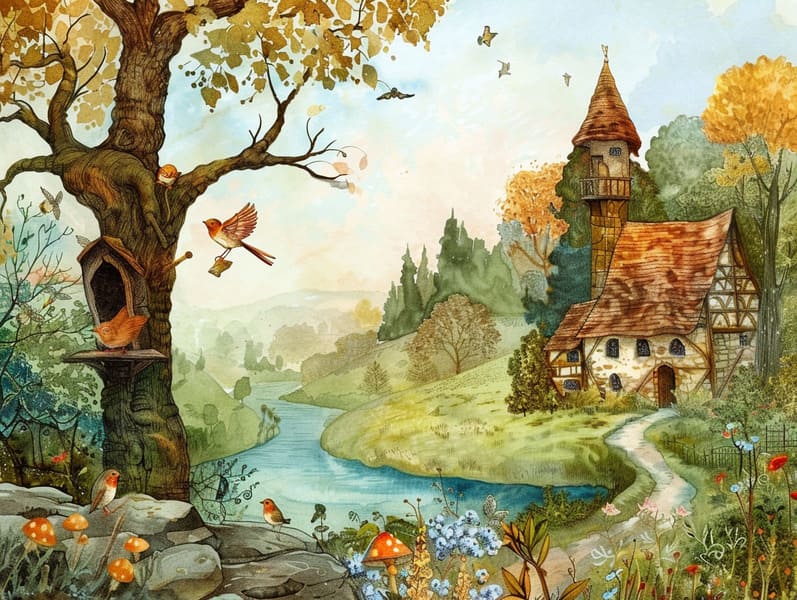The Beginning of Historical Fairy Tales with the Invariable Loveliness.
The Beginning of Historical Fairy Tales with the Invariable Loveliness.
Blog Article

Famous fairy tales have long histories. These stories have been recounted from one generation to the next millennia before they were ever written down. They originated from a variety of backgrounds, including European traditions. They were initially narrated among adults, often carrying themes and messages reflective of the societal norms and beliefs of the time.
Jacob and Wilhelm Grimm, Jacob and Wilhelm Grimm, were among the first to collect many of these beloved stories. Their volume, "Grimm's Fairy Stories," included tales like "Cinderella," "Little Brother and Little Sister," and "Snow White," which have since become classics in the world of children's fairy tales. Similarly, Hans Andersen's delightful tales, such as "The Mermaid's Tale," and "The Little Duckling," have stolen hearts worldwide, solidifying their place in the pantheon of iconic fairy tales.
Despite their historical roots, classic fairy tales remain as meaningful as ever, especially as children's night stories. These fantastical tales are now available in different formats, including gorgeously illustrated books, magical animations, and online fairy tales.
Their unwavering allure can be linked to several captivating elements:
Vital Lessons: Ancient fairy tales often share important moral lessons. Tales like "The Story of the Boy Who Cried Wolf" teach the value of sincerity, while "The Tale of the Tortoise and the Hare" demonstrate the virtues of persistence and unpretentiousness. These stories offer little ones clear distinctions between virtue and vice, developing their moral compass in a kind yet lasting way.
Empathy and Awareness: Classic fairy tales frequently include individuals facing tests and troubles, inciting young readers to comprehend with their struggles and rally behind their triumphs. For instance, "Beauty and Her Beast" highlights the significance of appreciating inner worth to comprehend the inner spirit of a character, enhancing kindness and discernment.
Cultural Comprehension: Many fairy tales are rich in the cultural contexts from which they arose. Engaging with these stories can provide fascinating glimpses into different ways of life, enhancing a sense of global respect and perception.
Fantasy and Innovation: The fantastical elements in traditional fairy tales—talking beasts—fuel children’s fantastical thinking. These narratives transport readers to fantasy realms, firing up creative thinking and a sense of delight that endures a lifetime.
Timeless fairy tales are not only bewitching but also enlightening. They provide entrancing tools in advancing various cognitive and affective skills in children. When ancient fairy tales are told out loud, they develop linguistic abilities by offering fairy tales new linguistic elements and sophisticated sentence structures. This practice also promotes hearing perception and focus, as young readers listen intently, looking forward to see what happens next.
Furthermore, debating the themes and characters of timeless fairy tales can cultivate cognitive skills and logical thinking. Little ones are taught to discover patterns, expect results, and understand cause and effect. These talks also aid kids speak out their thoughts and feelings, boosting their emotional intelligence.
In today’s modern era, the proliferation of free fairy tales online has made these fairy tales more obtainable than ever. Online resources and digital apps present comprehensive collections of classic fairy tales that can be explored or listened through anytime, anywhere. Fairy tales recited are particularly liked, giving an interactive method for little ones to engage with these bewitching tales. Audio stories and read-out-loud videos move characters and settings to life, often joined by magical sound effects and soundtracks that elevate the storytelling experience.
The lasting allure of timeless fairy tales lies in their ability to shift to modern society while holding onto their fundamental ideas. Contemporary revisions of these fairy tales often include more representative figures and modern settings, making them accessible to today’s audience. However, the core values of fearlessness, humanity, and justice remain unchanged, continuing to influence young listeners of all ages.
Ancient fairy tales also offer a sense of protection and homeliness. They present a methodical narrative with a recognizable beginning, middle, and end, often coming to a close with the termination of conflicts and the triumph of honesty over deceit. This uniformity can be placating for young ones, affording a sense of sturdiness in an variable world.
Traditional fairy tales continue to fascinate and educate new generations, maintaining their charm and significance in modern society. As nighttime stories for kids, they feature a perfect blend of enchantment and education, encouraging moral values, empathy, and creativity. The abundance of online storybooks and the favor of fairy tales recited ratify that these classic stories remain obtainable to new generations.
By conserving and communicating these stories, we continue to appreciate the rich tapestry of storytelling and cultural heritage. Whether you are reading a richly illustrated book, discovering a cyber library, or hearing an audiobook, the wonder of old fairy tales is always within reach. These fairy tales highlight of the unchanging effect of storytelling and its ability to hold us together across generations and cultures.
If you are perusing a artistically illustrated book, discovering a electronic collection, or listening via an read-aloud story, the loveliness of Grimm's fairy tales is always within reach.
These stories convey of the immortal effect of tales and its ability to tie us across time and space, forming a connection that fascinates and enlightens alike.